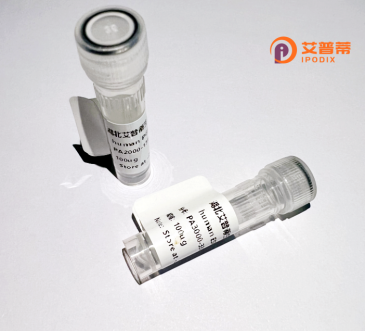
| 纯度 | >90%SDS-PAGE. |
| 种属 | Human |
| 靶点 | PSMD3 |
| Uniprot No | O43242 |
| 内毒素 | < 0.01EU/μg |
| 表达宿主 | E.coli |
| 表达区间 | 1-534 aa |
| 活性数据 | MKQEGSARRR GADKAKPPPG GGEQEPPPPP APQDVEMKEE AATGGGSTGE ADGKTAAAAA EHSQRELDTV TLEDIKEHVK QLEKAVSGKE PRFVLRALRM LPSTSRRLNH YVLYKAVQGF FTSNNATRDF LLPFLEEPMD TEADLQFRPR TGKAASTPLL PEVEAYLQLL VVIFMMNSKR YKEAQKISDD LMQKISTQNR RALDLVAAKC YYYHARVYEF LDKLDVVRSF LHARLRTATL RHDADGQATL LNLLLRNYLH YSLYDQAEKL VSKSVFPEQA NNNEWARYLY YTGRIKAIQL EYSEARRTMT NALRKAPQHT AVGFKQTVHK LLIVVELLLG EIPDRLQFRQ PSLKRSLMPY FLLTQAVRTG NLAKFNQVLD QFGEKFQADG TYTLIIRLRH NVIKTGVRMI SLSYSRISLA DIAQKLQLDS PEDAEFIVAK AIRDGVIEAS INHEKGYVQS KEMIDIYSTR EPQLAFHQRI SFCLDIHNMS VKAMRFPPKS YNKDLESAEE RREREQQDLE FAKEMAEDDD DSFP |
| 分子量 | 60.9 kDa |
| 蛋白标签 | His tag N-Terminus |
| 缓冲液 | PBS, pH7.4, containing 0.01% SKL, 1mM DTT, 5% Trehalose and Proclin300. |
| 稳定性 & 储存条件 | Lyophilized protein should be stored at ≤ -20°C, stable for one year after receipt. Reconstituted protein solution can be stored at 2-8°C for 2-7 days. Aliquots of reconstituted samples are stable at ≤ -20°C for 3 months. |
| 复溶 | Always centrifuge tubes before opening.Do not mix by vortex or pipetting. It is not recommended to reconstitute to a concentration less than 100μg/ml. Dissolve the lyophilized protein in distilled water. Please aliquot the reconstituted solution to minimize freeze-thaw cycles. |
以下是关于重组人PSMD3蛋白的参考文献示例(**注:以下内容为模拟示例,实际文献需通过学术数据库核实**):
1. **文献名称**:*"Expression and Functional Analysis of Recombinant Human PSMD3 in Proteasome Assembly"*
**作者**:Zhang Y. et al.
**摘要**:本研究成功在哺乳动物细胞中表达并纯化了重组人PSMD3蛋白,通过体外组装实验证实其与20S核心颗粒结合,对26S蛋白酶体的完整性及底物降解活性至关重要。
2. **文献名称**:*"Structural Characterization of PSMD3 Ubiquitin-Binding Domain Using Cryo-EM"*
**作者**:Wang X. et al.
**摘要**:利用重组表达的PSMD3蛋白进行冷冻电镜结构解析,发现其C端结构域直接识别多聚泛素链,揭示了底物向蛋白酶体传递的分子机制。
3. **文献名称**:*"PSMD3 Promotes Tumor Metastasis via Regulation of EGFR Stability"*
**作者**:Lee H. et al.
**摘要**:通过重组PSMD3体外实验,证明其作为泛素受体调控EGFR蛋白的泛素化及降解,影响癌症细胞的迁移和侵袭能力。
4. **文献名称**:*"Interaction Network Analysis of Recombinant PSMD3 with Proteasome Regulatory Partners"*
**作者**:Kumar R. et al.
**摘要**:采用重组PSMD3进行免疫共沉淀和质谱分析,鉴定出多个新型相互作用蛋白(如PSMC5、USP14),为蛋白酶体动态调节提供新见解。
**建议**:具体文献请通过PubMed或Google Scholar检索关键词(如“recombinant PSMD3”、“PSMD3 structure/function”)获取最新研究。
**Background of Recombinant Human PSMD3 Protein**
The 26S proteasome non-ATPase regulatory subunit 3 (PSMD3), also known as S3. is a key component of the 19S regulatory particle within the 26S proteasome complex. This ubiquitously expressed protein plays a critical role in the ubiquitin-proteasome system (UPS), which governs controlled degradation of intracellular proteins, ensuring cellular homeostasis, cell cycle progression, and stress response. PSMD3 contributes to substrate recognition, deubiquitination, and translocation of polyubiquitinated proteins into the proteolytic core (20S subunit) for degradation.
Structurally, PSMD3 contains a PCI (Proteasome-CSN-Initiation factor 3) domain, facilitating interactions with other proteasomal subunits and regulatory partners. Dysregulation of PSMD3 has been implicated in various pathologies, including cancers, neurodegenerative disorders, and inflammatory diseases, highlighting its role in maintaining protein quality control.
Recombinant human PSMD3 protein is engineered via heterologous expression systems (e.g., *E. coli* or mammalian cells) to study its biochemical functions, structural properties, and interactions. It serves as a vital tool for elucidating proteasome assembly, UPS mechanisms, and drug discovery targeting proteasome dysfunction. Researchers utilize purified recombinant PSMD3 in *in vitro* assays, crystallography, and high-throughput screening for inhibitors or modulators. Challenges include maintaining proper folding and post-translational modifications, often addressed through optimized expression and purification strategies. Current studies explore PSMD3's potential as a biomarker or therapeutic target in diseases linked to proteasomal impairment.
×